Editor's Pick
Reprinted from "Crown Jewels of the Wire", September 2001, page 48
Wouldn't you have had a difficult time choosing the winners of the displays?
However, the display that held the theme of the show was one that was not a
winner, except in the exceptional glass and history shared about the glass from
the southern states. Congrats, Jim Meyer.
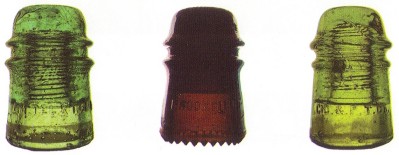
Three CD 121 toll insulators: AM. TEL. & TEL CO. bubbly and crude green;
BROOKFIELD with sharp drip points in amber; C.D. & P.T.Co. in yellow olive
green.
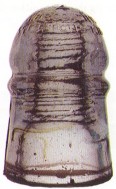
CD 126.3 BROOKFIELD in gray with blue and lavender tones was found on the
Central Georgia along with two CD 126 Brookfields purples.
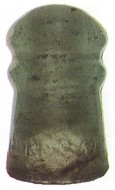
CD 126 RD 149959 in a jade green milkglass.
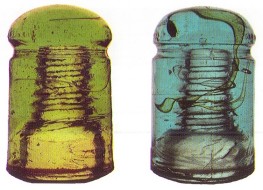
An early threaded telegraph insulator was represented by two fantastic CD 127
Brookfields. The one on the left is a yellow green, and look at the road of
amber ribbon running in the blue aqua item on the right.
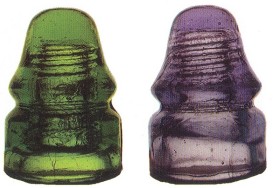
A number of spectacular Brookfield pieces were found in the south, including
these two CD 133s -- the yellow green and its companion, a piece that was found
in south Georgia, in a deep purple color. . .
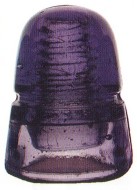
. . . and a very dark purple CD 145 Brookfield beehive.
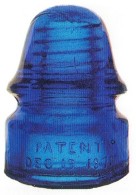
Many of the peacock blue CD 134 PATENT/DEC 19 1871 are weakly embossed,
however that is not the case with this piece found on the same crossarm with two
others close to Birmingham, Alabama on a railroad line.
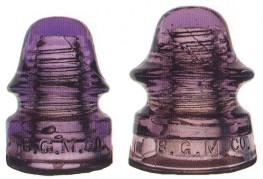
Two purple B.G.M. CO. signals in purple -- CD 134 and CD 164.

An olive green CD 187 and a green CD 188.
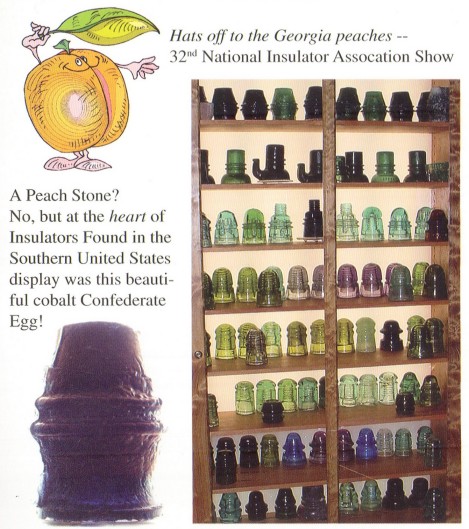
Cover Photo
The Hemingray 19 in cobalt blue is the only one ever found in the South, that
I know of. (See next to bottom row just left of center in photograph of display
front cover.) It was found on a large government installation. The man who found
it was there on business and he stated that he walked over to where one of the
poles had been and the insulators were lying on the ground. He brought home the
cob and several aquas and said he didn't look where any of the other poles had
been. The only reason he brought home the cobalt was because his wife loved the
color blue.
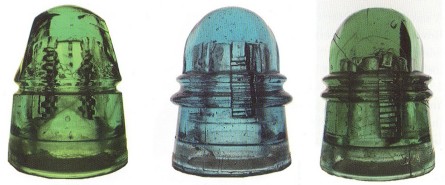
CD 158 Boston Bottle Works in green at the left and two CD 158.2 Bostons, one
in blue and the other in green.
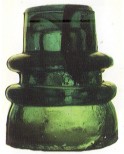
CD 736.4 in a nice green and a...
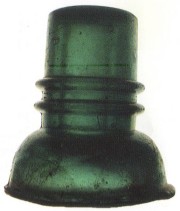
CD 737 in light aqua which was dug
behind the telegraph station in Blakely, Alabama.
Several interesting threaded insulators found in the south were a CD 164
Hemingray in orange amber in the railroad yard in Grenada, Mississippi; a CD 145
H.G.Co. in yellow green in Mississippi; an aqua Cutter tree insulators in a tree
at a river crossing in north Florida; a yellow olive CD 145 American and a CD
106.1 Duquesne in cornflower in South Carolina; a CD 127 Homer Brookes in aqua
along the Georgia Railroad.
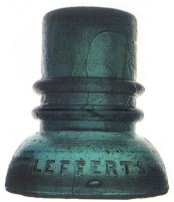
Joining the CD 737 Lefferts and the...

CD 1000 block found in the
south are some threadless pieces: a teal CD 731 Tillotson on an old building in
New Orleans; Yandell's Patent (CD 1014) in milky green near Lake Pontchartrain;
a CD 701.5 in teal with original pin at a Florida river crossing; CD 740 in
blackglass in Florida; an a teapot in apple lime-green behind the Blakely,
Alabama telegraph station.
Of course the stories behind the "teapots", the Richmond dig and
the Confederate "eggs", and the addition of the elusive CD 158.9
screwtop Boston Bottle Works in amber were the headliners in Jim's display.
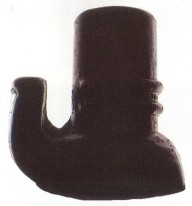
Above is a beautiful teapot that passes enough light to see aqua along
the edge of the spout. Below is an transparent aqua egg and the cover cobalt egg
on its side to show you the brilliance of its color.
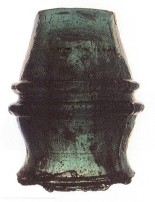
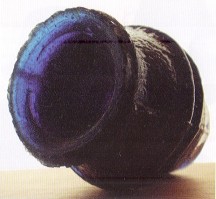
In the middle of the third row (see cover) you find the amber CD 158.9
flanked by two in aqua. Notice how dark the amber piece is; however, turn it on
its side .... ya'll have never seen a more gorgeous piece of glass found in the
south.
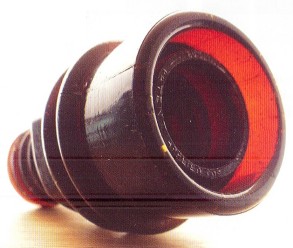
Congratulations, Jim, on a marvelous representation of southern glass and the
history that you shared on each piece.
| 